|
|
The objectives, activities and expected outputs for both the
biophysical and policy research are outlined in
table 3.
-
Characterization of the biophysical and policy
evironment will be undertaken at each of the proposed study areas.
Specific emphasis will be given to an analysis of conditions under
which farmers have already started to modify slash-and-burn systems
and intensify land use. Such information will be derived from prior
studies of land-use systems and from more specific reviews of farms
within these systems.
-
Using outputs from biophysical, socio-economic and
policy research, a regional, geographically referenced database will
be developed for the purpose of synthesizing regional information and
identifying key socioeconomical and biophysical determinants and
processes leading to slash-and-burn agriculture and deforestation. The
regional GIS database will provide the global framework under which
the research will be conducted and have potential impact.
-
For both biophysical and socioeconomic reasons, not all
land-use systems currently practised as alternatives to slash-and-burn
are sustainable. To evaluate the sustainability of these systems, it
is important that criteria be developed against which the systems can
be assessed. These criteria will be established by a global working
group consisting of participants from the three regions and other
experts from relevant research areas. The criteria will be tested in a
few selected areas.
-
Based on the information gathered regionally and
synthesized globally, and utilizing the sustainability criteria,
potential alternatives to slash-and-burn agriculture will be
identified and documented in a geographically referenced database.
This database will provide a global reference point for sharing and
transferring information for regional and local research initiatives,
and the potential relevance and introduction of new alternatives.
-
To provide a focus for research and intervention, and
based on agroecological and socioeconomic criteria, priority
identification domains will be named in each study area. Given the
wide spectrum of potential interventions, this activity will maximize
the chances for the adoption and impact of sustainable alternatives
through the identification of priorities for technology development
and system improvement.
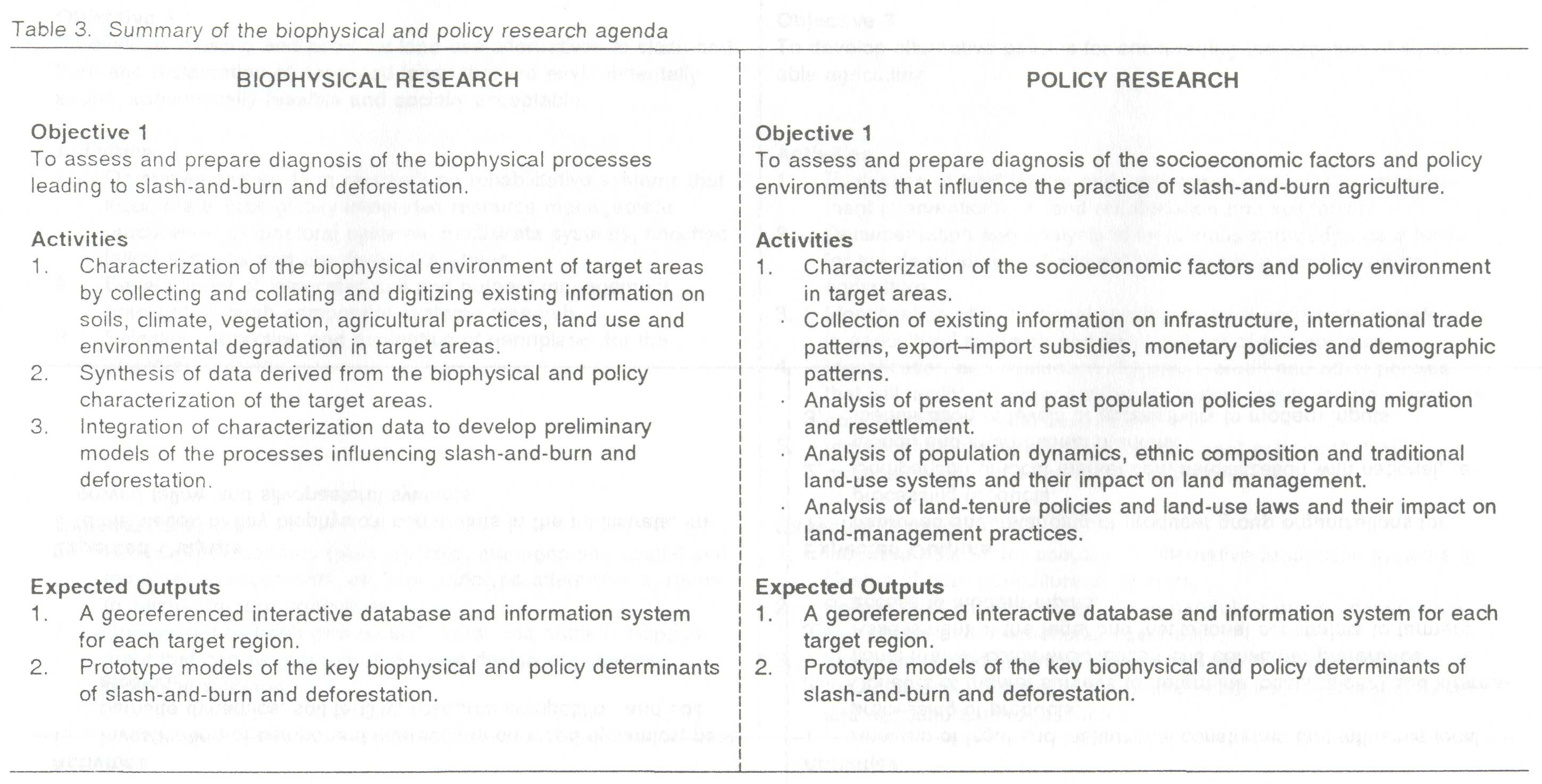
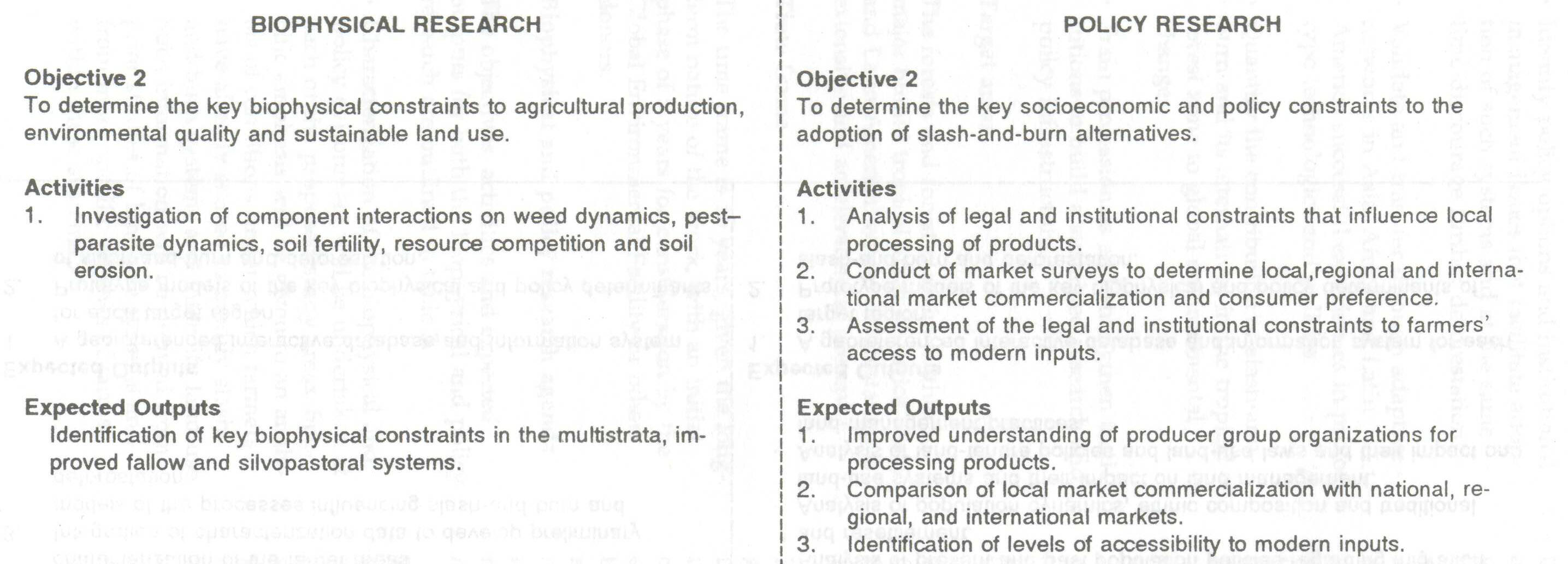
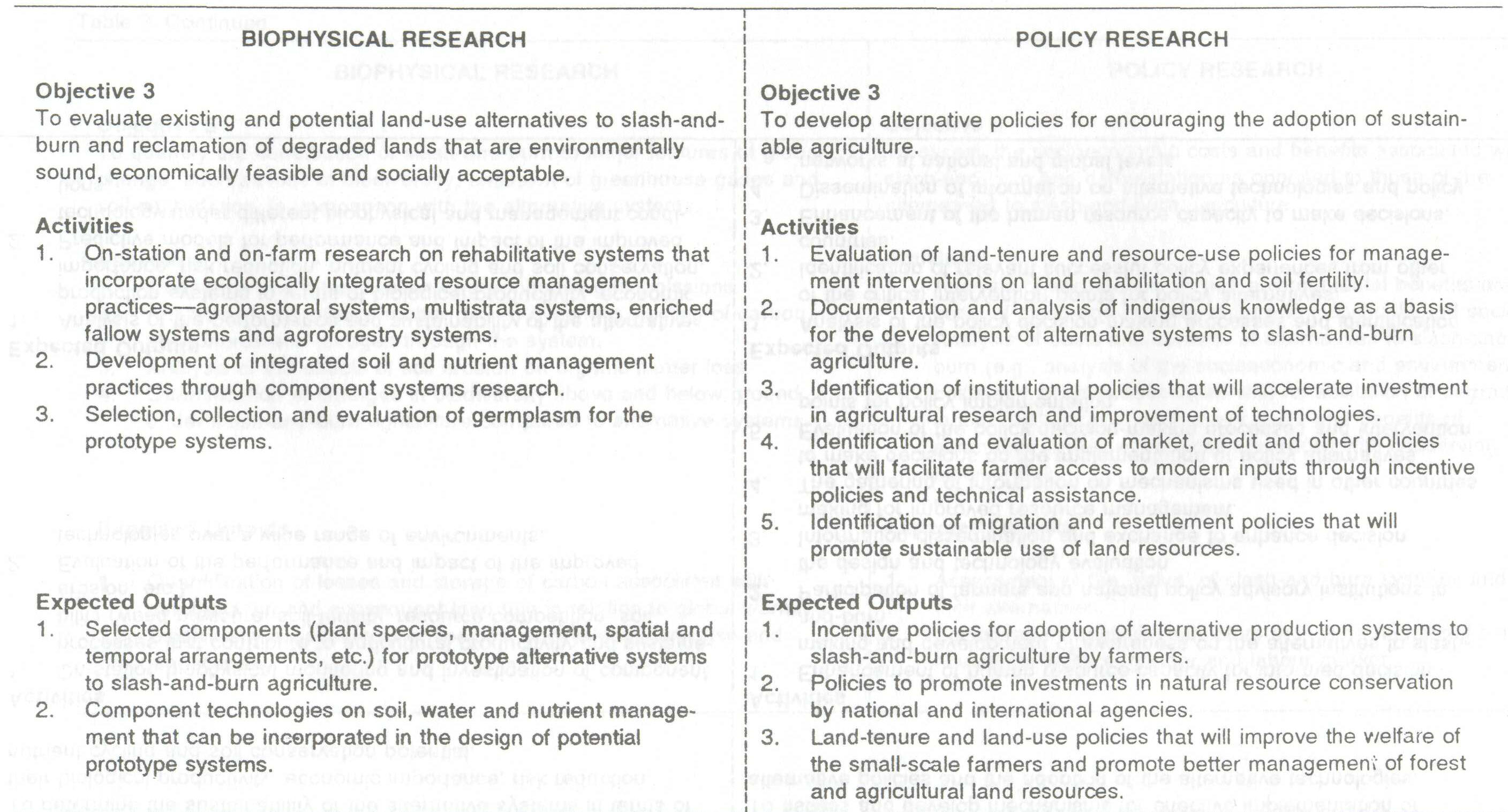
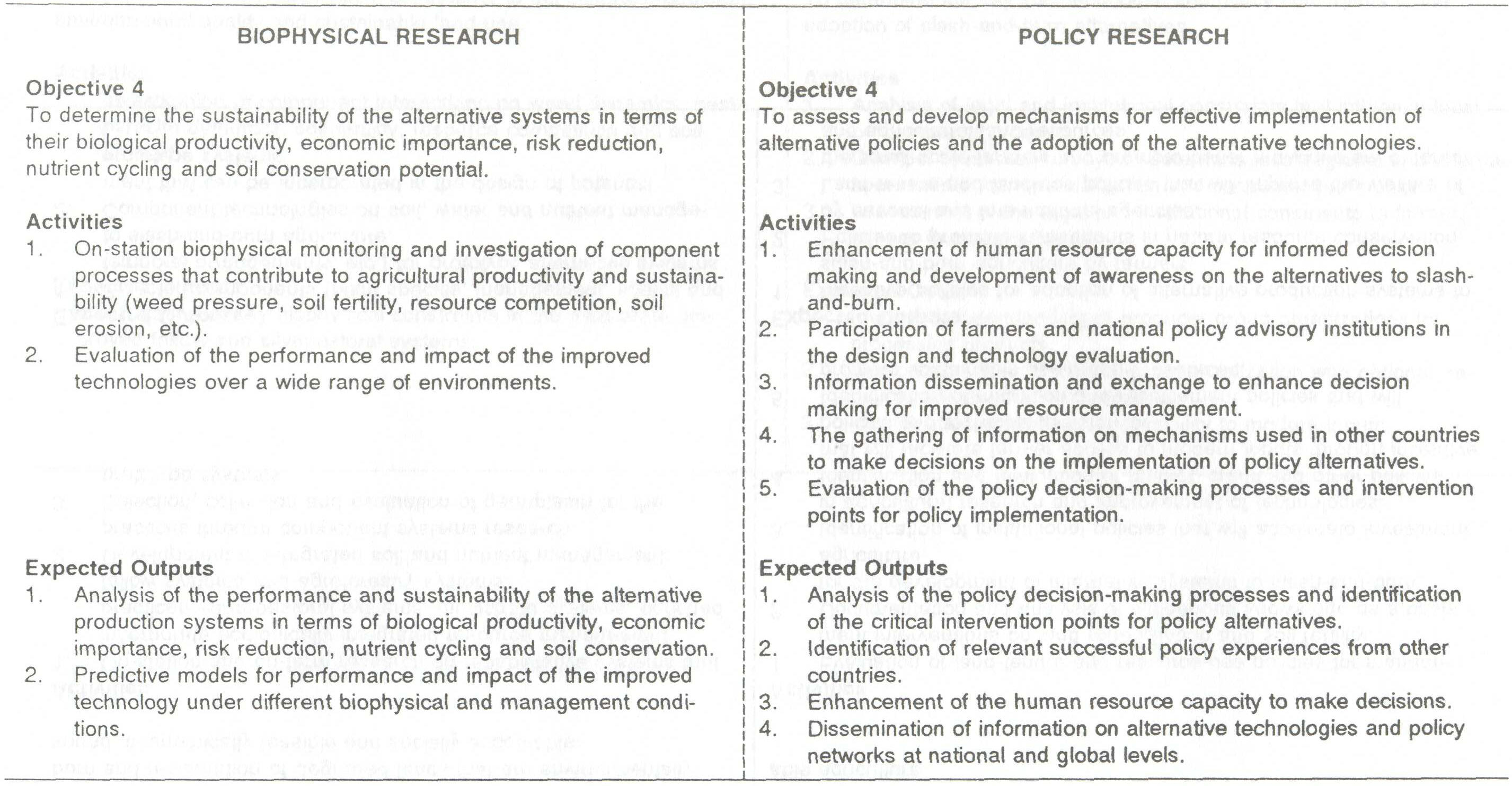
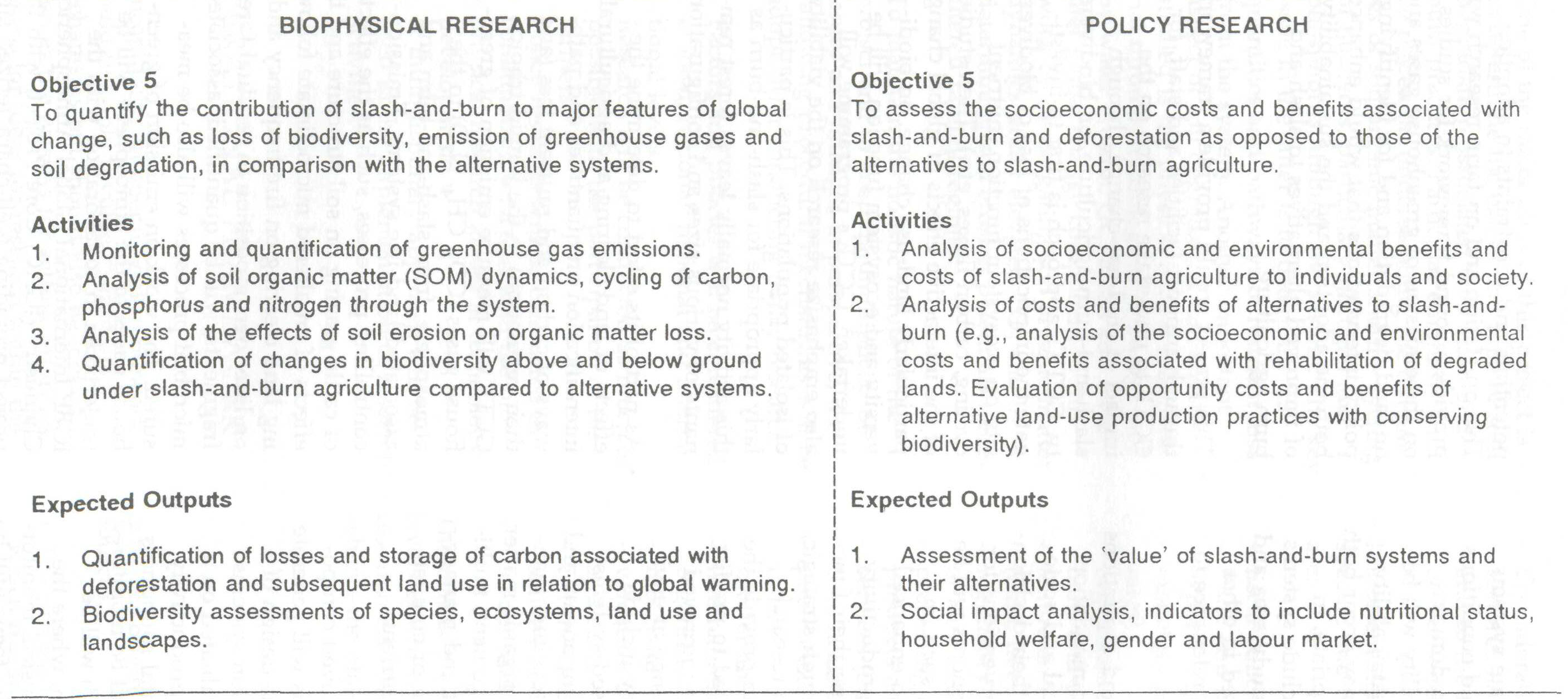
-
At each study area, candidate systems will be evaluated
under field conditions in priority recommendation domains, and their
relative sustainability will be determined utilizing the
sustainability criteria. Such evaluations may occur both on-station,
or where appropriate, in farmers' fields, and will include systems
currently practised in the study area and sustainable systems
practised in other ecoregions but of potential relevance to new
situations.
-
Based on the perceptions and aspirations of farmers in
priority recommendation domains and the biophysical and socio-economic
factors affecting their decision-making processes, key interventions
for the improvement of components will be identified. The potential of
such improvements to contribute to enhanced system sustainability and
productivity, and the principles governing their function, will be
evaluated through strategic, process-oriented on-station research.
Such research is essential to provide the basic understanding required
to predict performance and impact of improved technology over a wider
range of environments. Such studies may include agroforestry or
legume-based systems with specific studies on components and processes
such as nutrient cycling, management of crops and soil organic matter,
weed dynamics and management, multipurpose tree improvement and
management, and resource sharing or competition for light, water and
nutrients.
-
Strategic research on improved components and their
interactions will generate information that allows the design of
improved or new production systems. These systems must be evaluated on
a long-term basis and their productivity, sustainability,
environmental soundness and social acceptability will be monitored and
assessed. Such research will be undertaken both on-station, where the
emphasis will be on biophysical monitoring, and on-farm, where the
focus will be on assessing the social acceptability, potentials and
constraints to adoption. This on-station and on-farm research will
provide a sound framework for studies on the emission of greenhouse
gases and on land degradation and for identifying policy interventions
that would enhance both the adoption and the sustainability of
improved alternatives to slash-and-burn agriculture.
-
This project would provide a framework, through support
facilities and staff, for GCTE to undertake research on the impact of
land-use change, through slash-and-burn agriculture, on biodiversity.
GCTE's approach is first to investigate the implications of loss of
biodiversity on ecosystem function (nutrient cycling, carbon fluxes,
etc.). Then studies of the interactive effects of global change,
particularly land-use change, on biodiversity and ecosystem function
will be undertaken. GCTE's programme will also emphasize research on
the viability of isolated populations. This is particularly
appropriate for slash-and-burn as this activity normally leaves forest
remnants of various sizes and configurations.
-
As part of its effort to determine the effects of land
clearing and agricultural intensification on quantities and pathways
of carbon and nutrient loss (and their regulation) in the humid
tropics, GCTE will measure emission of greenhouse gases (CO2,
CH4, N2O) to the atmosphere, from slash-and-burn
and associated land-use systems. Emission-controlling processes, such
as the effects of cattle grazing on soil structure and the effects of
an altered microclimate following land clearing on fire frequency and
on litter decomposition in residual forest fragments, will be
quantified; associated microbial processes will also be measured. The
work on emission of greenhouse gases to the atmosphere will be
undertaken in collaboration with the IGBP International Global
Atmospheric Chemistry (IGAC) Core Project, with this project providing
well-characterized sites and support facilities, where appropriate.
-
One of the major aims of this project is to determine
the extent and type of soil degradation associated with slash-and-burn
practices. Particular emphasis will be placed on understanding the
dynamics of soil organic matter and the cycling of nutrients,
particulary nitrogen and phosphorus, through the system. The key issue
in the latter is to determine the quantities and pathways of nutrient
loss from the system. Another important aspect of soil degradation
that will be studied is the physical loss of soil material through
hydrological pathways and by water erosion. GCTE can add a further
global change component to this work by investigating soil organic
matter dynamics under elevated CO2 and by determining soil
erosion potentials under altered rainfall regimes.
-
To maintain the holistic nature of the project and to
keep the multiplicity of issues and linkages in perspective, the
following procedural mechanisms will be adopted for conducting policy
research:
-
Factors and policies will be considered at local,
regional, national and international levels.
-
Research will be conducted as much as possible
with the participation of the farmers.
-
Policy research will be conducted in continuous
interaction with the biophysical research aimed at technology
development.
-
A multidisplinary approach will be used in the
implementation of research activities.
-
Consideration will be given to inter-sectorial
and intrasectorial linkages and to the relationships among on-site and
off-site factors.
-
fiscal policies (taxes, subsidies, etc.)
-
trade and market policies (imports and exports
regulations and taxes)
-
monetary policies (credit, interest rates)
-
organization policies (farmers' associations and
participation, NGOs)
-
tenure and property rights policies (land, trees,
water, biodiversity)
-
regulatory policies (regulations on use of land
and natural resources)
-
processing and marketing (agricultural products
and inputs)
-
services (extension, transport, education,
health, communications)
-
population growth and related policy issues
-
gender and family issues
-
international institutions (development
organizations, donors, etc.)
-
indigenous cultural and rights issues
-
valuation of environmental benefits and costs
-
Off-the-land alternatives for economic activity
and employment
-
labour and employment issues
The matrix presented in table 4 shows the levels at which
socioeconomic and policy research activities will be conducted to
achieve the objectives of the project. |



